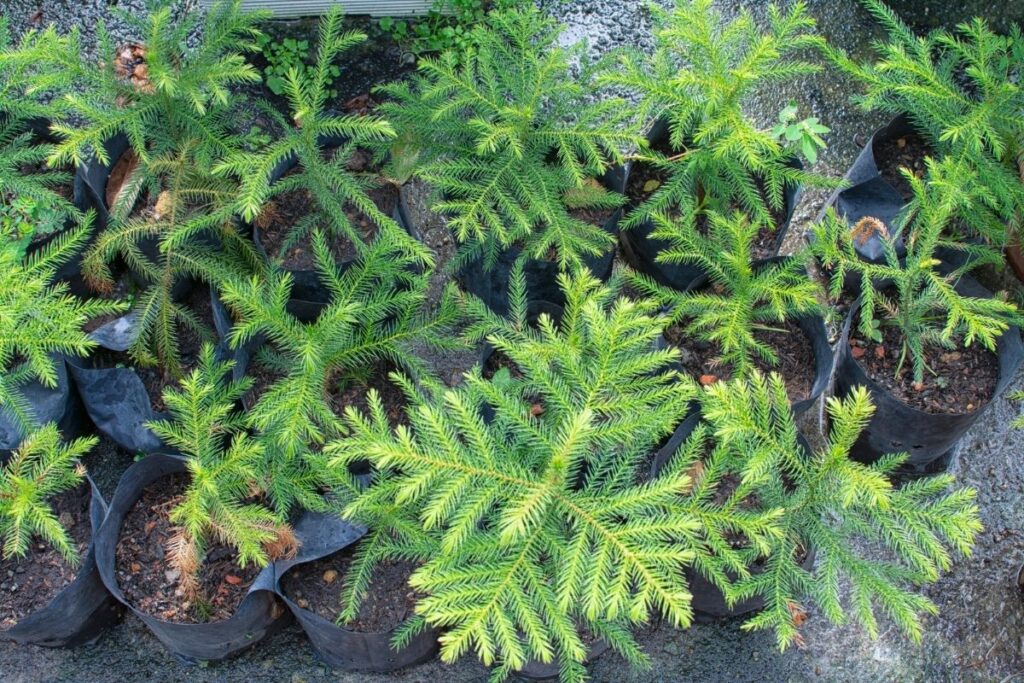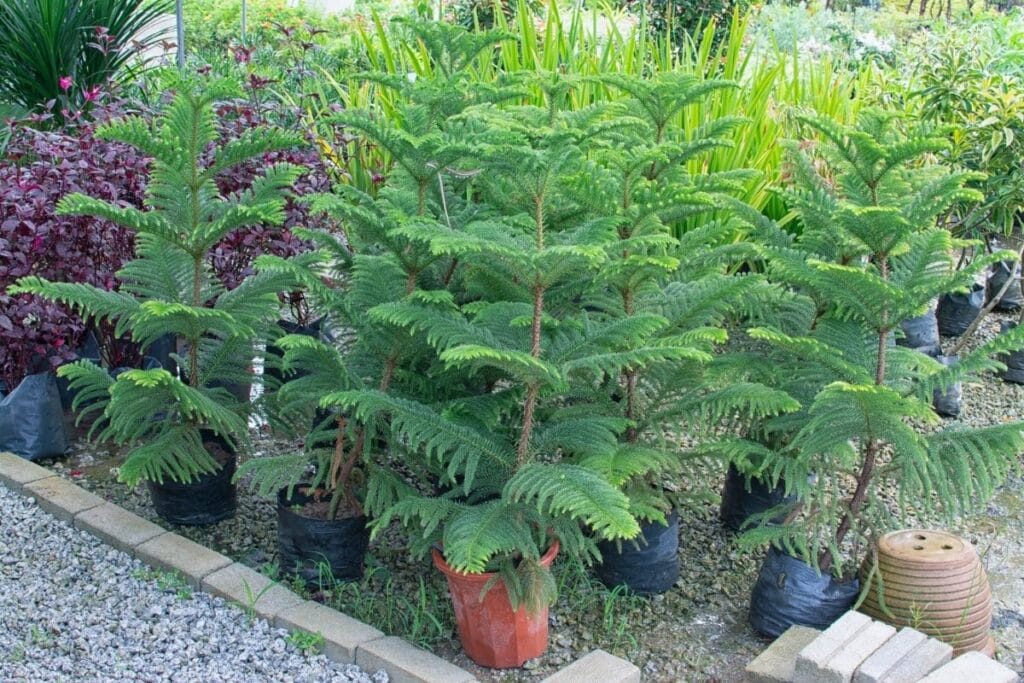Every year when the festive season comes around, small Norfolk Island pines become available, often bedecked in glitter and ornaments, or even painted. They usually survive for a few weeks before slowly dying away.
With the right care, however, these tiny Christmas trees can live for many years as fantastic houseplants. Read on to learn how to grow and care for these plants in the long term.
The Norfolk Island Pine is not really a pine at all, although it is a conifer. In nature, this evergreen tree grows slowly to an amazing height of 200 feet (60m) or more. They are usually seen for sale around the festive season because they have a great Christmas tree shape.
They are, in fact, subtropical plants, and northern winters are not at all suitable for outdoor growth. The green, needle-covered branches are soft when young, becoming spinier when mature. Their symmetrical, whorled branches look amazing when viewed from above.
Plant Facts
| Scientific name | Araucaria heterophylla |
| Common names | Christmas tree, Polynesian pine, star pine, triangle tree |
| Family | Araucariaceae |
| Plant Type | Coniferous tree |
| Height and Width | 6-7 ft. tall (indoors), 3-4 ft. wide (indoors) |
| Origin | Norfolk Island |
| Flower colors | None |
| Foliage color | Green |
| Sun Exposure | Direct sunlight, dappled light, bright indirect light |
| Soil Type & pH | Well-drained, acidic soil |
| Special features | Large houseplant, Conifer, Slow grower |
How to Grow a Norfolk Pine Tree
The Norfolk island pine trees can be grown outdoors as a fine evergreen tree. Many gardens are simply too cold for the species, however. Fortunately, this tropical plant is slow-growing indoors and makes an excellent houseplant.
Propagation
It is possible to propagate your own Norfolk Island pine tree, although most growers choose to buy established plants. This species can be grown from seed that germinates within 10-15 days. Seeds should be sown on the surface of the medium, rather than buried.
Soil
Norfolk Island Pine prefers slightly acidic and sandy soil. If you are growing it indoors, use a potting mix that is porous, sandy, and slightly acidic. Adding extra peat moss and sand to a standard potting mix will improve acidity and porosity.
Keep the soil damp but not soggy, and give the plant as much light as possible.
Pruning
Pruning this plant is not generally necessary or advisable. Dead or unhealthy growth can however be removed to keep the plant neat and healthy.
Repotting and Transplanting
Young Norfolk Island pines have a relatively small and weak root system. This means that great care should be taken when transplanting the pot and repotting should be avoided unless necessary. The species can easily outgrow its space in the home if given plenty of room, so keeping it contained to a relatively small container is advisable.
You should consider repotting If the container the plant came in is unsuitable, or the plant is heavily rootbound after 2 years of growth or so. It is very important to grow this plant in a pot with drainage holes to prevent root rot. A heavy container that is about 2 inches (5cm) larger, and has good drainage holes is the recommended choice.

How to Care for a Norfolk Island Pine Indoors
Whether you’ve bought this plant impulsively around Christmas time or bought a larger specimen from a garden center, there are some important things to know about its care. Read on for more indoor Norfolk island pine care tips.
Water
These norfolk pines require frequent watering, but should not be left to stand in water. This is why a free-draining growing medium and a container with drainage holes are so important. Don’t wait until your plant looks dry, at that point it may already be too late.
Feel the soil regularly to work out the ideal watering schedule for your plant. It’s time to water norfolk island pine when the soil has dried out to a depth of about an inch. Water enough so that it begins to drain out of the bottom of the container, that way you know you’ve watered the soil through.
Sunlight
Norfolk Island Pine (Araucaria heterophylla) thrives in bright, indirect sunlight. While it can tolerate some direct sun, particularly during the morning or late afternoon, prolonged exposure to intense bright light may cause its needles to burn or scorch.
Placing the plant near a south- or west-facing window where it can receive filtered sunlight or partial shade throughout the day is ideal for promoting healthy growth and maintaining its vibrant green foliage.
Avoid placing Norfolk Island Pine in dark or excessively shady locations, as this can lead to leggy growth and poor development.
Temperature and Humidity
The Norfolk pine comes from a moderate, frost-free climate. It is a coastal plant, which prefers moist air.
It is not frost tolerant, so do not expose the living Christmas tree to temperatures below 50°F and position it away from cold draughts. Take care to keep the plant warm when transporting it from the store to your home.
You can maintain a humid environment around your indoor plant by placing its container over a pebble- and water-filled tray or using a room humidifier. You can also mist the foliage lightly once a week.
Fertilizer
The Norfolk Island pine does not require much in the way of fertilizer. Apply a balanced all-purpose fertilizer in the spring once new growth appears, and on into the summer months if you wish. Avoid feeding in the fall and winter as this can result in thin, leggy growth.
Pest and diseases
The most commonly seen issues relate to over and underwatering. Branches may droop and needles may turn brown due to stress from underwatering. Yellow needles can also indicate a lack of water, but be sure to feel the soil as this may also be a sign of overwatering.
Like other plants, root rot can develop in Norfolk island pines grown without adequate drainage and leaning or tipping may occur due to uneven access to light or loose soil. Scale insects, mealybugs, and thrips have all been reported.
Conclusion
The Norfolk pine makes a great indoor potted plant for the festive season like a Christmas tree but also deserves a spot in the home for the rest of the year especially as a bonsai pine tree. For the best results, choose a specimen that hasn’t been painted or covered in glitter, and remember to keep the plant moist and warm.
*image by sweemingyoung/depositphotos
References
Reference list:
Chase, A. R., Osborne, L.S. & Poole, R.T. Norfolk Island Pine
Production Guide
Deardorff, D. & Wadsworth, K. What’s Wrong With My Houseplant. Save Your Indoor Plants With 100% Organic Solutions
Close







